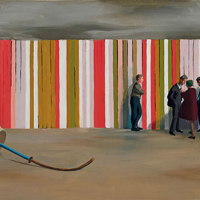41. JEFFREY SMART

The subject of Jeffrey Smarts Study for The Discussion is typically ambiguous: a discussion may be a dispute, argument, conversation or conference. The painting can be several things too: is it a figure group, a contemporary landscape, or a commentary on contemporary art? Is it humorous or serious, or could it be both?
We know from his own statements that Smarts paintings often have their genesis in banal landscapes or incidents, often perceived out of peripheral vision whilst travelling. His paintings also often reveal clues to where he has been, through references and influences that indicate recent artistic experience. A favourite artist of the moment might find himself recycled in Smarts next painting, or become a regular motif. The torn and weathered posters and hoardings which begin to occur in his work in the early 1960s, for example (and which still occur as a motif in his work in 2008), recall the French and Italian artists such as Mimmo Rotella (1918-2006) and Jacques Villegl (born 1926) who pioneered dcollage in the late 1950s. Smarts relationship to contemporary art is an unusual one. It often contains a note of cynicism. The striped wall, which is the main feature of the present painting might be a reference to the American Color Field painter Gene Davis (1920-1985) or Bridget Riley (born 1931), the British Op Art painter and designer who came to prominence in the late 1960s. In 1968, the year before the present work was painted, Riley was the British representative at the Venice Biennale.
It is tempting to see the woman, who is the central figure of the group, as Bridget Riley herself. Smarts later portraits, in particular of Clive James, and Margaret Olley, where the sitter inhabits an ironic environment at odds with his or her public persona, develop this concept more fully. Riley (if it is her) has managed to engage the interest of one or two of the men who surround her, while two further figures, one of whom leans against the wall that is the painting itself are more passively involved. Another figure who has either ostentatiously or rudely turned his back on her, is not buying her argument. He may alternatively be seen as the only one in the group to be at least looking at the work itself. The various attitudes of the participants in the discussion are mirrored in the curved posts which recede on the left, each facing in a different direction. The division of opinion in the group is underlined by the diagonal shadow, which bisects the figures. The discussion takes place in a bleak and sterile landscape with the sea in the distance and an overcast sky.
Smart is a student of the old and modern masters, so such an interpretation is far from far fetched. He occupies a unique position, as a contemporary painter, because he works with traditional methods operating on a parallel course with the diversity of contemporary art.
By 1969, Jeffrey Smart was able to enjoy his status as a professional artist. He could rely on his art for his income, could travel widely (in 1969 he was in London, New York, Greece and Austria), and was exhibiting regularly in Europe (in 1968 in Rome, in 1970, London) and Australia (exhibitions at South Yarra Gallery in 1968, Macquarie Galleries, Sydney, in 1969). By October 1970 he was sufficiently established to put a deposit on Posticcia Nuova, a farmhouse not far from Arezzo in Tuscany. This was to become his home and remained so until death in 2013. The present painting was therefore produced at an interesting stage in Smarts career. His success provided him with the confidence to explore the art world through his work, and indulge in a public discussion with the leading artists of his own time.
Timothy Abdallah BA